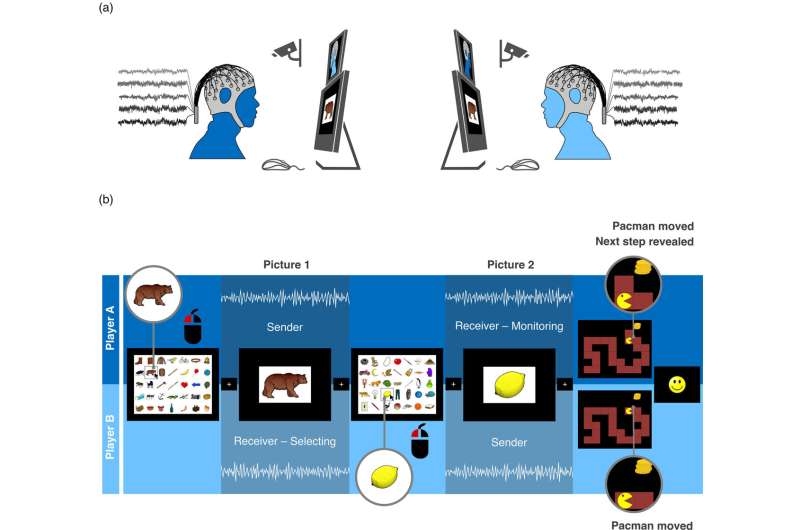This article has been reviewed according to Science X's editorial process and policies. Editors have highlighted the following attributes while ensuring the content's credibility:
fact-checked
trusted source
proofread
Using Pacman to study cooperative behavior

Intense focus pervades the EEG laboratory at the University of Konstanz on this day of experimentation. In separate labs, two participants, connected by screens, engage in the computer game Pacman. The burning question: Can strangers, unable to communicate directly, synchronize their efforts to conquer the digital realm together?
Doctoral candidate Karl-Philipp Flösch is leading today's experiment. He states, "Our research revolves around cooperative behavior and the adoption of social roles." However, understanding brain processes underlying cooperative behavior is still in its infancy, presenting a central challenge for cognitive neuroscience. How can cooperative behavior be brought into a highly structured EEG laboratory environment without making it feel artificial or boring for study participants?
Pacman as a scientific 'playground'
The research team, led by Harald Schupp, Professor of Biological Psychology at the University of Konstanz, envisioned using the well-known computer game Pacman as a natural medium to study cooperative behavior in the EEG laboratory. Conducting the study as part of the Cluster of Excellence Centre for the Advanced Study of Collective Behavior, they recently published their findings in Psychophysiology.
"Pacman is a cultural icon. Many have navigated the voracious Pacman through mazes in their youth, aiming to devour fruits and outsmart hostile ghosts," reminisces Karl-Philipp Flösch. Collaborating with colleagues, co-author Tobias Flaisch adapted the game. In the EEG version, two players, instead of one, must collaboratively guide Pacman to the goal. Flaisch explains, "Success hinges on cooperative behavior, as players must seamlessly work together."
However, the researchers have built in a special hurdle: the labyrinth's path is concealed. Only one of the two players can see where Pacman is going next. Flösch elaborates, "The active player can communicate the direction to the partner, but only indirectly using pre-agreed symbols, communicated solely through the computer screen."
If you do not remember quickly enough that a crescent moon on the screen means that Pacman should move right and that only the banana on the keyboard can make Pacman move to the right, you're making a mistake. "From the perspective of classical psychological research, the game combines various skills inherent in natural social situations," notes Harald Schupp.
EEG measures event-related potentials
During each game, the players' brain reactions were measured using EEG. Calculating event-related potentials provides a detailed view of the effects elicited by different game roles with millisecond-level temporal precision. The team hypothesized that the game role significantly influences brain reactions.
Therefore, they examined the P3 component, a well-studied brain reaction exhibiting a stronger deflection in the presence of significant and task-relevant stimuli.
The results confirmed their assumption, "The P3 was increased not only when the symbol indicated the next move's direction but also when observing whether the game partner selected the correct symbol," says Flösch. The team concludes that the role we take on during cooperation determines the informational value of environmental stimuli situationally. EEG measurements allow the brain processes involved to be dynamically mapped.
"Cooperative role adoption structures our entire society," says Schupp. "An individual achieves little alone, but humanity collectively reaches the moon. Our technological society hinges on cooperative behavior," says Flösch, adding that children early on take individual roles, thereby learning the art of complex cooperation.
Consequently, this role adoption occurs nearly effortlessly and automatically for us every day. "Our brains are practically 'built' for it, as evidenced by the results of our study."
More information: Karl‐Philipp Flösch et al, Dyadic cooperation with human and artificial agents: Event‐related potentials trace dynamic role taking during an interactive game, Psychophysiology (2023). DOI: 10.1111/psyp.14433


















